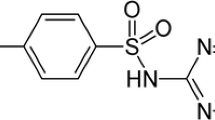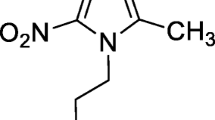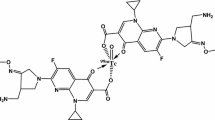Abstract
Nitrofurantoin (NFN) radiolabeling with technetium-99m (99mTc) was investigated using different concentration of the NFN, sodium pertechnetate (Na99mTcO4), reducing agent (SnCl2) at different pH ranges (5.1–6.00). The suitability of the 99mTc-NFN was evaluated in terms of the radiochemical purity (RCP) yield, in vitro stability in saline, serum, in vitro binding with E. coli, biodistribution in E. coli infected model rat (ERT), and scintigraphic accuracy in E. coli infected model rabbit (EBT). The superlative radiochemical succumb at 2.5 mg NFN, 125 μL of SnCl2 (1 μg/μL in 0.01 N HCl), 2.5 mCi of Na99mTcO4, at pH 5.2 at 30, 60, 90, and 120 min after reconstitution was 64.50 ± 0.11, 97.50 ± 0.16, 94.25 ± 0.10, 92.15 ± 0.14 and 90.75 ± 0.0.13%. The complex was found stable in saline and serum for 90% up to 120 min and showed 50–65% in vitro binding with E. coli. The absorption of the 99mTc-NFN, primarily at E. Coli infected (ECT) muscle of ERT was lower but after 60 min it went up to 7.25 ± 0.17%. The absorption in the blood, liver, spleen, stomach, intestines, inflamed muscle (N.T1) and normal muscle (N.T2) went down while in the kidney and urine it went up with time. The ratio of the ECT/N.T1 was 7:1 and N.T2/N.T1 was 2:1. The Whole Body Static (WBS) imaging of the ERB confirmed the suitability of the 99mTc-NFN as radiotracer. The superlative radiochemical succumb, significant in vitro stability in saline and serum, in vitro binding with E. coli, ideal biodistribution and scintigraphic accuracy confirmed the viability of the 99mTc-NFN as radiotracer for infection.
Similar content being viewed by others
Avoid common mistakes on your manuscript.
Introduction
A wide range of techniques are available for the early diagnosis of infection and its discrimination from inflammation. Amongst all the Radionuclide Scintigraphy (RS) showed promising results for in vivo localization of infectious foci at early stages [1, 2].
The existing radiotracers akin to 67Ga-citrate, 111In-WBC and the labeled peptides showed encouraging results but the factors that limit their suitability and usefulness include the intricate availability, high radiation dose and awkward labeling procedure [3, 4]. The technetium-99 m labeled ciprofloxacin [5], ciprofloxacin dithocarbamate [6], lomefloxacin and ofloxacin [7], cefuroxine [8], pefloxacin [9], kanamycin [10], sparafloxacin [11], moxifloxacin [12], sitafloxacin [13], and rifampicin [14], after intensive evaluation have been anticipated for infection imaging that opening new ways for exploration of a new class of imaging agents.
Nitrofurantoin (NFN); (E)-1-[(5-nitro-2-furyl) methylideneamino] imidazolidine-2,4-dione (Fig. 1), is an another antibiotic (bacteriocidal) oftenly intended for the Urinary Tract Infection (UTI) caused by E. coli showing resistance to other antibiotics. NFN is also safe in pregnancy as and when it is used in combination with sulfisoxazole [15]. The mechanism of action of NFN is unique and complex as it damaged the pathogen Deoxy Ribonucleic Acid (DNA) in its reduced form. Flavoproteins (nirofuran reductase) in the pathogen cell rapidly reduced the NFN into multiple reactive intermediate that attack ribosomal DNA, respiration, pyruvate metabolism and other macromolecules [16].
To exploit the bacteriocidal activity of the NFN, herein, we report the radiolabeling of NFN with technetium-99 m, its in vitro radiochemical stability in saline, serum, binding with E. coli, biodistribution in E. coli infected rat (ERT) and scintigraphic accuracy in E. coli infected rabbit (ERB).
Experimental
Materials
Nitrofurantoin (Macrodantin USA, TLC strips (Merck), and all the other chemicals and solvents of analytical grade (Sigma). RP-HPLC (Shimadzu, Japan), well counter, scalar count rate meter (Ludlum USA), Dose calibrator (Capintech USA), and the Gamma camera (GEADE Nuclearmedizine system, Germany).
Method
Synthesis of 99mTc-nitrofurantoin complex
Stannous chloride (1 μg/μL in 0.01 N HCL), 25 μL (with 25 μL rise) to 250 μL were taken in 10 sterile vials. The pH of the vials was set between 5.1 (with 0.1 augmentation) to 6 and nitrofurantoin (NFN), 0.5 (with 0.5 mg tallying) to 5.0 mg was added to it. Thereafter, 0.5 (with 0.5 mCi rise) up to 5.0 mCi of sodium pertechnetate was aseptically poured and the preparations were incubated at room temperature followed by filtration prior to investigation.
HPLC analysis
Shimadzu SCL-10 AVP system, equipped with SDP-10 AVP UV detector operating at 254 nm, Packard 500 TR series flow scintillation analyzer, binary pump, online degasser, was used for determination of % yield of 99mTc-NFN, free 99mTc and radio-colloids applying the reported method [13]. Briefly, 5 μL of the preparation was injected into C-18 column (4.6 × 150 mm, 5 μM) followed by 1 mL/min water:acetonitrile (10:90) elution. The fraction collected (1 mL/min) was analyzed for of % yield of 99mTc-NFN, free 99mTc and radio-colloids at 30, 60, 90 and 120 min after reconstitution using well counter interface with scalar count rate meter (WCSR).
In vitro stability in saline
In vitro stability of the 99mTc-NFN complex was investigated using the reported HPLC method [14], Briefly, 10 μL of the 99mTc-NFN complex was injected to the C-18 column (4.6 × 150 mm, 5 μM) of the shimadzu SCL-10 AVP system, with SDP-10 AVP UV detector operating at 254 nm, Packard 500 TR series flow scintillation analyzer, binary pump, using online degasser, with a flow rate of 1 mL/min for 15 min using water:acetonitrile (W:A) (10:90) as the mobile phase. The labeled complex was examined for in vitro stability in serum at 30, 60, 90, and 120 min. The eluent collected at 1–15 min of separation was collected vials and counted for % in vitro stability of the complex using gamma well counter.
In vitro stability in serum
In serum the in vitro stability of the 99mTc-NFN was evaluated by incubating 0.2 mL of the complex in saline with 1.8 mL of serum at 37 °C for 120 min. Aliquots, 1 μL at 1–120 min (in incubation period) were applied to the TLC strip. The strip after drying was developed in acetone and ethanol:ammonia:water (2:1:5). The developed TLC strips were divided at (Rf 5) and counted for activity, using gamma rays well counter.
In vitro binding with Escherichia (E.) coli
Binding of 99mTc-NFN with E. coli was determined by the reported method [17], briefly, 0.1 mL of sodium phosphate buffer (Na–PB) containing 10 MBq of the 99mTc-NFN was shifted to a test tube and 0.8 mL of 50% (v/v) of 0.01 M acetic acid in a Na-PB containing approximately 1 × 108 colony forming units (CFU) pathogen were added to it followed by incubation at 4 °C for 1 h with a final pH 5 and centrifugation at 2000 rpm for 5 min. The supernatant was removed and the bacterial pellet was resuspended in 1 mL of Na-PB and recentifuged as above. The supernatant was removed and the E. coli pellet was counted for activity using gamma well counter. The activity related with bacteria was expressed as % of the added activity bound to bacteria in regard to the total activity. In vitro binding efficacy of 99mTc-NFN was compared with 99mTc-sitafloxacin (99mTc-STF), 99mTc-rifampacin (99mTc-RMP).
Biodistribution in rat
Bacterial broth containing 1 × 108 colony forming units (CFU) in 0.1 mL saline was injected intramuscularly (I.M) into the right thigh of the anaesthetized male Sprague–Dawley rat: weight range, 150–200 g. After 12 h sterile turpentine oil was injected I.M into the left thigh followed by intravenous administration of 0.1 mL (37 MBq) of 99mTc-NFN. The rats were scarified in accordance with the guide lines of the Nuclear Medicine Research Laboratory University of Peshawar. Accurately, one gram each of the blood, infected (IFT), inflamed (IFM), normal (NL) muscle, liver, spleen and kidney were weighed and percent injected dose absorbed per gram (% I.D/g) was calculated using gamma well counter.
Scintigraphy of rabbit
Escherichia coli, 0.5 mL in saline containing 1 × 108 CFU was intramuscularly injected to the right thigh of the anesthetized New Zealand white rabbits (male, weight: 3.0–4.0 kg) and after 10 h 0.5 mL autoclaved sterile turpentine oil to the left thighs. Afterward, 0.2 mL (2 mCi) of the 99mTc-NFN complex was intravenously administered and the rabbit was placed prone on the bed of the Gamma camera equipped with low energy general purpose collimator (LEGPC). Whole body images (WBS) of the rabbits were obtained at 15, 30, 45, 60 and 90 min of injection.
Results and discussion
Yield of 99mTc-nitrofuratonin complex
The radio-chromatogram of the 99mTc-NFN complex showed different peaks at retention time 5.1 and 14.8 min as shown in Fig. 2. The radio peak at 14.8 min represents the 99mTc-NFN complex. The 99mTc-NFN prepared by mixing 2.5 mg NFN, 125 μL of SnCl2 (1 μg/μL in 0.01 N HCl), and 2.5 mCi of Na99mTcO4, at pH 5.2, gave 97.50 ± 0.16% 99mTc-NFN, 0.55 ± 0.16% free 99mTc and 2.00 ± 0.12% radio-colloids after 30 min of reconstitution and was found stable in saline up to 120 min for more than 90% as shown in Fig. 3. The % yield of 99mTc-NFN, free 99mTc and radio-colloids are given in Table 1.
99mTc can complex with the bidentate nitrofurantoin through one of the nitrogen and C=O and between two molecules of the ligand (Fig. 1b). At pH 5–6 SnCl2 reduces Tc(VII) to Tc(V)3+ which get stabilized by the ligand. By analogy to Cu(II) complex derived from 5-nitrofuran-2-carboxaldehyde [18], the complex will have a square pyramidal geometry, 1:2 stoichiometry of Tc:Ligand., with the coordination number five, with the oxidant core Tc(V)3+ and a negative charge on the 99mTc.
Effect of nitrofurantoin, stannous chloride, sodium pertechnetate and pH
The effect of nitrofurantoin (NFN), stannous chloride, sodium pertechnetate and pH on the radiochemical purity yield of the 99mTc-NFN is shown in Fig. 4. The maximum RCP yield of the 99mTc-NFN observed by mixing 2.5 mg NFN, 125 μL of SnCl2 (1 μg/μL in 0.01 N HCl), and 2.5 mCi of Na99mTcO4, at pH 5.2 was 97.50 ± 0.16% .
In vitro stability in serum
The undesirable activity observed in vitro in serum at 37 °C after 120 min of incubation for the 99mTc-NFN complex was 9.15 ± 0.14% (n = 10). The comparative in vitro stability profile of 99mTc-NFN, 99mTc-STF and 99mTc-RMP in serum at 37 °C is given in Fig. 5.
In-vitro binding with Escherichia (E.) coli
The 99mTc-NFN prepared by mixing NFN (2.5 mg), SnCl2 (125 μL), Na99mTcO4 (2.5 mCi) at pH 5.2 showed 50–65% (n = 15) binding with E. coli, while that for 99mTc-STF and 99mTc-RMP was 45–55% (n = 15) and 55–60% (n = 15) respectively.
Biodistribution into the E. coli infected rats
The percent absorption of the 99mTc-NFN in blood, E. coli infected (ECT) muscle, inflamed (T1) muscle, normal (T2) muscle, liver, spleen, stomach, intestines, kidney and urine of the ERT are given in Table 2. After 30 min of the administration 26.25 ± 0.22, 3.60 ± 0.0.18, 2.25 ± 0.16, 1.50 ± 0.0.18, 24.50 ± 0.14, 6.80 ± 0.0.15, 18.15 ± 0.18, 2.25 ± 0.17 and 4.15 ± 0.14% of the injected dose was observed in blood, ECT muscle, T1 muscle, T2 muscles, liver, spleen, stomach & intestines, kidney and urine respectively. Within 90 min the absorption of the complex in the ECT muscle increased from 3.60 ± 0.18 to 7.25 ± 0.17% and decreased from 2.25 ± 0.016 to 1.5 ± 0.15% in the T1 muscle. No change in T2 (control) muscle was observed and the uptake was 1.50%, during the analysis. Decrease in the order of activity in all the organs of the ERT was observed with the exception of kidney, urine and ECT muscle, which inveterate the typical itinerary of excretion of the 99mTc-NFN complex as infection radiotracer from the body.
Scintigraphy of E. coli infected rabbits
After 15 min of the intravenous injection of the 99mTc-NFN normal appearance in the whole body of the EBT was observed. The appearance of activity in the ECT (target organ) muscle and T1 muscle was zilch after 15 min of scintigraphy. After 30 min of injection the activity slightly appeared in the ECT muscle and T1 muscle. After 45 min, simultaneously, the appearance of activity in ECT and disappearance from T1 muscle was observed. Maximum activity uptake was noted in ECT and almost similar negligible level of activity was observed in T1 and T2 (control) muscle after 60 min as shown in Fig. 6. After 90 min no change in the scan was observed with regard to the uptake in ECT, T1 and T2 muscle.
Conclusion
99mTc-NFN complex, a new radiotracer for in vivo infection was synthesized that showed soaring in vitro stability in saline and serum, lofty binding with Escherichiacoli, precise and suitable in vivo distribution in ERT and infection imaging accuracy in EBT. In view of the exceeding facts, we recommend the 99mTc-NFN as promising radiotracer for in vivo infection.
References
Bar-Shalom R, Yefremov N, Guralnik L, Keidar Z, Engel A, Nitecki S, Israel O (2006) J Nucl Med 47:587
Rusckowski M, Gupta S, Liu G, Dou S, Hnatowich DJ (2004) J Nucl Med 45:1201
Sarda L, Cremieux A, Lebellec Y, Meulemans A, Lebtahi R, Hayem G, Genin R, Delahaye N, Huten D, Guludec DL (2003) J Nucl Med 44:920
Oyen WJG, Boerman OC, Storm G, van Bloois L, Koenders EB, Claessens RAMJ, Perenboom RM, Crommelin DJA, van der Meer JWM, Corstens FHM (1996) J Nucl Med 37:1392
Hong Z, Ning-yi J, Lin Z (2009) Chin Med J 16:1907
Zhang J, Guo H, Zhang S, Lin Y, Wang X (2008) Bioorg Med Chem Lett 18:5168
Motaleb MA (2007) J Radioanal Nucl Chem 272:95
Lumbrecht FY, Yilmaz O, Unak P, Seytigolu B, Durkan K, Baskan H (2008) J Radioanal Nucl Chem 277:491
El-Ghany EA, Amine AM, El-Sayed AS, El-Kolaly MT, Abdel-Gelil F (2005) J Radioanal Nucl Chem 266:125
Roohi S, Mustaq A, Jehangir M, Malik SA (2006) J Radioanal Nucl Chem 267:561
Motaleb MA (2009) J Labelled Comp Radiopharm 52:415
Chattopadhyay S, Das SS, Chandra S, De K, Mishra M, Sarkar BR, Sinha S, Ganguly S (2010) Appl Radiat Isot 68:314
Qaiser SS, Khan AU, Khan MR (2010) J Radioanal Nucl Chem 284:189
Qaiser SS, Khan AU, Khan MR (2010) Appl Radiat Isot. doi:10.1016/j.apradiso.2010.05.014
Lima-Neto P, Correia AN, Portela RR, Juliao MS, Linhares-Junior GF, de Lima JES (2010) Talanta 80:1730
Sastry SS, Jayaraman R (1985) Arch Biochem Biophys 236:252
Welling MM, Lupetti A, Balter HS, Lanzzeri S, Souto B, Rey AM, Savio EO, Paulusma-Annema A, Pauwels EKJ, Nibbering PH (2001) J Nucl Med 42:788
Sharma S, Athar F, Maurya MR, Naqvi F, Azam A (2005) Eur J Med Chem 40:557
Author information
Authors and Affiliations
Corresponding author
Rights and permissions
About this article
Cite this article
Shah, S.Q., Khan, A.U. & Khan, M.R. Radiosynthesis of 99mTc-nitrofurantoin a novel radiotracer for in vivo imaging of Escherichia coli infection. J Radioanal Nucl Chem 287, 417–422 (2011). https://doi.org/10.1007/s10967-010-0697-z
Received:
Published:
Issue Date:
DOI: https://doi.org/10.1007/s10967-010-0697-z










